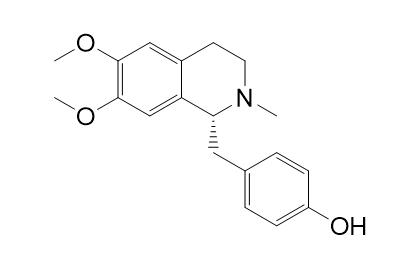Armepavine
Armepavine exerts both in vitro and in vivo antifibrotic effects in rats, with inhibition of NF-κB, JunD and C/EBPß pathways. It also shows cytotoxic activity.
Inquire / Order:
manager@chemfaces.com
Technical Inquiries:
service@chemfaces.com
Tel:
+86-27-84237783
Fax:
+86-27-84254680
Address:
1 Building, No. 83, CheCheng Rd., Wuhan Economic and Technological Development Zone, Wuhan, Hubei 430056, PRC
Providing storage is as stated on the product vial and the vial is kept tightly sealed, the product can be stored for up to
24 months(2-8C).
Wherever possible, you should prepare and use solutions on the same day. However, if you need to make up stock solutions in advance, we recommend that you store the solution as aliquots in tightly sealed vials at -20C. Generally, these will be useable for up to two weeks. Before use, and prior to opening the vial we recommend that you allow your product to equilibrate to room temperature for at least 1 hour.
Need more advice on solubility, usage and handling? Please email to: service@chemfaces.com
The packaging of the product may have turned upside down during transportation, resulting in the natural compounds adhering to the neck or cap of the vial. take the vial out of its packaging and gently shake to let the compounds fall to the bottom of the vial. for liquid products, centrifuge at 200-500 RPM to gather the liquid at the bottom of the vial. try to avoid loss or contamination during handling.
Vojnosanit Pregl2016, 75(00):391-391
Brain Res Bull.2024, 218:111103.
Phytomedicine.2019, 67:153159
Tumour Biol.2015, 36(9):7027-34
J Med Food.2021, 24(2):151-160.
Oxid Med Cell Longev.2020, 2020:8887251.
Molecules.2023, 28(4):1526.
Int J Mol Sci.2021, 22(19):10220.
J Agric Food Chem.2020, 68(51):15164-15175
Int J Mol Sci.2023, 24(15):12397.
Related and Featured Products
Pharmazie. 2000 Sep;55(9):688-9.
Phytochemical study and cytotoxic activity of alkaloids from Uvaria chamae P. Beauv.[Pubmed:
11031775]
METHODS AND RESULTS:
Phytochemical study of leaves of Uvaria chamae resulted in the isolation for the first time for the genus Uvaria of benzylisoquinoline alkaloids (+)-Armepavine (1) and racem. O,O-dimethylcoclaurine (2). The aporphines nornantenine (3), nantenine (4) and corydine (7) are new for the species.
CONCLUSIONS:
The alkaloids were found to express cytotoxic activity against L 929 transformed cells. The highest activity was shown by 1, 3, and 5. At a concentration corresponding to their IC50 against L929 cells, they were nontoxic against mouse thymocytes.
Phytother Res. 2012 Mar;26(3):344-53.
Effects of armepavine against hepatic fibrosis induced by thioacetamide in rats.[Pubmed:
21717514 ]
The aim of this study was to investigate if Armepavine (Arm, C₁₉H₂₃O₃N) could exert inhibitory effects against hepatic fibrosis in rats.
METHODS AND RESULTS:
A cell line of rat hepatic stellate cells (HSC-T6) was stimulated with tumour necrosis factor-α (TNF-α) to evaluate the inhibitory effects of Arm. Rats were injected with thioacetamide (TAA; 300 mg/kg, intraperitoneally) thrice a week for 4 weeks to induce hepatic fibrosis, with Arm (3 or 10 mg/kg) given by gavage twice a day. Liver sections were taken for western blotting, fibrosis scoring and immunofluorescence staining. Arm (1-10 µm) concentration-dependently attenuated TNF-α-stimulated: (i) protein expressions of α-smooth muscle actin (α-SMA), collagen type I and angiopoietin-1; (ii) H₂O₂ production; and (iii) NF-κB, JunD and C/EBPß (cytidine-cytidine-adenosine-adenosine-thymidine (CCAAT)/enhancer binding protein-ß (EBPß)) nuclear translocations in HSC-T6 cells. In vivo Arm treatment significantly reduced plasma aspartate transaminase and alanine transaminase levels, hepatic α-SMA expression and collagen contents, and fibrosis scores of TAA-injected rats. Moreover, Arm treatment decreased α-SMA- and NF-κB-positive cells in immunohistochemical staining, and mRNA expression levels of IL-6, TGF-ß1, TIMP-1, col1α2, iNOS and ICAM-1 genes, but up-regulated the metallothionein gene in the livers of TAA-injected rats.
CONCLUSIONS:
Our results indicated that Arm exerted both in vitro and in vivo antifibrotic effects in rats, with inhibition of NF-κB, JunD and C/EBPß pathways.
Molecules. 2016 Jul 19;21(7).
Quantitative Determination of Alkaloids in Lotus Flower (Flower Buds of Nelumbo nucifera) and Their Melanogenesis Inhibitory Activity.[Reference:
WebLink]
A quantitative analytical method for five aporphine alkaloids, nuciferine (1), nornuciferine (2), N-methylasimilobine (3), asimilobine (4), and pronuciferine (5), and five benzylisoquinoline alkaloids, Armepavine (6), norArmepavine (7), N-methylcoclaurine (8), coclaurine (9), and norjuziphine (10), identified as the constituents responsible for the melanogenesis inhibitory activity of the extracts of lotus flowers (the flower buds of Nelumbo nucifera), has been developed using liquid chromatography-mass spectrometry.
METHODS AND RESULTS:
The optimum conditions for separation and detection of these 10 alkaloids were achieved on a πNAP column, a reversed-phase column with naphthylethyl group-bonded silica packing material, with CH₃CN-0.2% aqueous acetic acid as the mobile phase and using mass spectrometry equipped with a positive-mode electrospray ionization source. According to the protocol established, distributions of these 10 alkaloids in the petal, receptacle, and stamen parts, which were separated from the whole flower, were examined.
CONCLUSIONS:
As expected, excellent correlations were observed between the total alkaloid content and melanogenesis inhibitory activity. Among the active alkaloids, nornuciferine (2) was found to give a carbamate salt (2'') via formation of an unstable carbamic acid (2') by absorption of carbon dioxide from the air.



